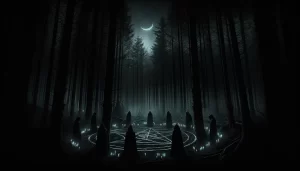Demonology

Demonology is the study or belief system that examines demons, evil spirits, or malevolent deities. It encompasses the study of their history, hierarchy, intentions, methods of interacting with humans, and ways to combat them. Demonology is present in many religions and mystical traditions around the world, including Christianity, Islam, Judaism, and various pagan beliefs.
Origins of Demonology
Demonology’s roots can be traced back to ancient civilizations, where beliefs in malevolent spirits were widespread. In Mesopotamia, demons were thought to be responsible for diseases, misfortune, and evil deeds. Similarly, ancient Egyptian religion included the concept of hostile forces that needed to be combated through magic and rituals.
In Judaism, the idea of demons evolved over time, with early texts seldom mentioning them. However, by the Second Temple period, belief in demons became more prevalent, influenced by Zoroastrianism during the Babylonian Exile. Christianity and Islam further developed these ideas, incorporating demons into their theological frameworks.
The Christian Perspective
In Christianity, demonology is heavily influenced by the Bible, church fathers, and later theological works. Demons are considered fallen angels who rebelled against God under the leadership of Satan. They are depicted as malevolent entities seeking to lead humans away from God.
The New Testament contains numerous accounts of Jesus casting out demons, highlighting the belief in demonic possession and the power of divine authority over evil spirits. This laid the foundation for later Christian demonology, including the classification of demons, the study of possession, and exorcism practices.
The Ars Goetia and the Lesser Key of Solomon
One of the most famous grimoires in Western occultism is the Lesser Key of Solomon, specifically its first section, the Ars Goetia. It describes 72 demons that King Solomon is said to have summoned and controlled. This text includes their names, ranks, appearances, and the specific rituals required to evoke them. The Ars Goetia remains a pivotal work in demonology, reflecting the fascination with the occult and the desire to understand and harness the powers of the unseen.
Demonology in Islam
In Islam, demons are known as jinn, beings created from smokeless fire. While some jinn are good and obedient to God, others, led by Iblis (Satan), are malevolent and seek to mislead humans. The Qur’an and Hadith literature offer guidance on protecting oneself from the harm of jinn through prayer, recitation of specific verses, and living a righteous life.
Conclusion
Demonology, with its rich and varied history, continues to captivate the human imagination. It offers a window into the fears, beliefs, and hopes of different cultures and religions. The study of demons reveals much about the human condition and our ongoing struggle to understand the forces of darkness and light.










